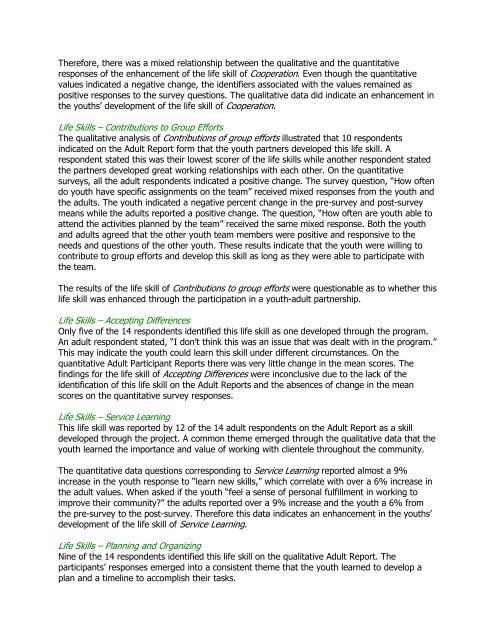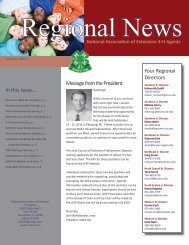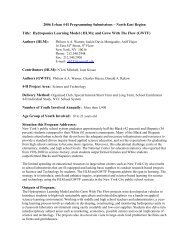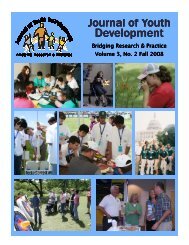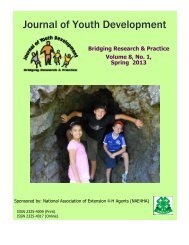Winter 2008 - Vol. 3 No. 3 - National Association of Extension 4-H ...
Winter 2008 - Vol. 3 No. 3 - National Association of Extension 4-H ...
Winter 2008 - Vol. 3 No. 3 - National Association of Extension 4-H ...
- No tags were found...
Create successful ePaper yourself
Turn your PDF publications into a flip-book with our unique Google optimized e-Paper software.
Therefore, there was a mixed relationship between the qualitative and the quantitativeresponses <strong>of</strong> the enhancement <strong>of</strong> the life skill <strong>of</strong> Cooperation. Even though the quantitativevalues indicated a negative change, the identifiers associated with the values remained aspositive responses to the survey questions. The qualitative data did indicate an enhancement inthe youths’ development <strong>of</strong> the life skill <strong>of</strong> Cooperation.Life Skills – Contributions to Group EffortsThe qualitative analysis <strong>of</strong> Contributions <strong>of</strong> group efforts illustrated that 10 respondentsindicated on the Adult Report form that the youth partners developed this life skill. Arespondent stated this was their lowest scorer <strong>of</strong> the life skills while another respondent statedthe partners developed great working relationships with each other. On the quantitativesurveys, all the adult respondents indicated a positive change. The survey question, “How <strong>of</strong>tendo youth have specific assignments on the team” received mixed responses from the youth andthe adults. The youth indicated a negative percent change in the pre-survey and post-surveymeans while the adults reported a positive change. The question, “How <strong>of</strong>ten are youth able toattend the activities planned by the team” received the same mixed response. Both the youthand adults agreed that the other youth team members were positive and responsive to theneeds and questions <strong>of</strong> the other youth. These results indicate that the youth were willing tocontribute to group efforts and develop this skill as long as they were able to participate withthe team.The results <strong>of</strong> the life skill <strong>of</strong> Contributions to group efforts were questionable as to whether thislife skill was enhanced through the participation in a youth-adult partnership.Life Skills – Accepting DifferencesOnly five <strong>of</strong> the 14 respondents identified this life skill as one developed through the program.An adult respondent stated, “I don’t think this was an issue that was dealt with in the program.”This may indicate the youth could learn this skill under different circumstances. On thequantitative Adult Participant Reports there was very little change in the mean scores. Thefindings for the life skill <strong>of</strong> Accepting Differences were inconclusive due to the lack <strong>of</strong> theidentification <strong>of</strong> this life skill on the Adult Reports and the absences <strong>of</strong> change in the meanscores on the quantitative survey responses.Life Skills – Service LearningThis life skill was reported by 12 <strong>of</strong> the 14 adult respondents on the Adult Report as a skilldeveloped through the project. A common theme emerged through the qualitative data that theyouth learned the importance and value <strong>of</strong> working with clientele throughout the community.The quantitative data questions corresponding to Service Learning reported almost a 9%increase in the youth response to “learn new skills,” which correlate with over a 6% increase inthe adult values. When asked if the youth “feel a sense <strong>of</strong> personal fulfillment in working toimprove their community?” the adults reported over a 9% increase and the youth a 6% fromthe pre-survey to the post-survey. Therefore this data indicates an enhancement in the youths’development <strong>of</strong> the life skill <strong>of</strong> Service Learning.Life Skills – Planning and OrganizingNine <strong>of</strong> the 14 respondents identified this life skill on the qualitative Adult Report. Theparticipants’ responses emerged into a consistent theme that the youth learned to develop aplan and a timeline to accomplish their tasks.


